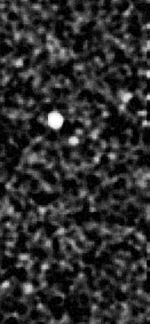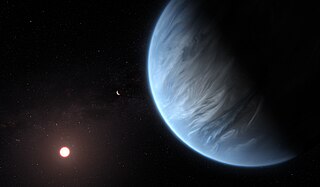K2-3b, also known as EPIC 201367065 b, is an exoplanet orbiting the red dwarf K2-3 every 10 days. It is the largest and most massive planet of the K2-3 system, with about 2.1 times the radius of Earth and about 5 times the mass. Its density of about 3.1 g/cm3 may indicate a composition of almost entirely water, or a hydrogen envelope comprising about 0.7% of the planet's mass.
K2-22b is an exoplanet 801 ly from Earth, rapidly orbiting the red dwarf K2-22 with an orbital period of 9.145872 hours. It has a mass below 445 Me and a radius below 2.5 Re. The planet was not detected in the K2 photometry. K2 photometry reveals the presence of an anomalous light curve consistent with evaporation of dust from the planet. This dust forms a tail both ahead and behind the planet, similar to some comets in the Solar System. The evaporation of this dust requires a low surface gravity from the host planet, implying it is a low mass, "Mars, Mercury, or even lunar sized bodies with surface gravities of 1/6 to 1/3 that of Earth are to be preferred."
K2-24b also known as EPIC 203771098 b is an exoplanet orbiting the Sun-like star K2-24 every 21 days. It has about the same density as Saturn, at 0.7103 g/cm3, which indicates that the planet is clearly a gas giant.
K2-24c also known as EPIC 203771098 c is an exoplanet orbiting the Sun-like star K2-24 every 42 days. It has a density far lower than that of Saturn, which indicates that the planet is clearly a gas giant.

K2-33b is a very young super-Neptune exoplanet, orbiting the pre-main-sequence star K2-33. It was discovered by NASA's Kepler spacecraft on its "Second Light" mission. It is located about 456 light-years away from Earth in the constellation of Scorpius. The exoplanet was found by using the transit method, in which the dimming effect that a planet causes as it crosses in front of its star is measured.
K2-72 is a cool red dwarf star of spectral class M2.7V located about 217 light-years away from the Earth in the constellation of Aquarius. It is known to host four planets, all similar in size to Earth, with one of them residing within the habitable zone.

K2-72e (also known by its EPIC designation EPIC 206209135.04), is a confirmed exoplanet, likely rocky, orbiting within the habitable zone of the red dwarf star K2-72, the outermost of four such planets discovered in the system by NASA's Kepler spacecraft on its "Second Light" mission. It is located about 217.1 light-years (66.56 parsecs, or nearly 2.0538×1015 km) away from Earth in the constellation of Aquarius. The exoplanet was found by using the transit method, in which the dimming effect that a planet causes as it crosses in front of its star is measured.

K2-138, also designated EPIC 245950175 or EE-1, is a large early K-type main sequence star with a system of at least 6 planets discovered by citizen scientists. Four were found in the first two days of the Exoplanet Explorers project on Zooniverse in early April 2017, while two more were revealed in further analysis. The system is about 660 light-years away in the constellation Aquarius, within K2 Campaign 12.
K2-148b is a confirmed super-Earth, probably rocky, closely orbiting a small orange dwarf star. It is the innermost of three Super-Earths around the star K2-148, which is in a wide binary pair with the M0.5V red dwarf EPIC 220194953. K2-148b is the smallest planet of the system, at about a third larger than Earth, and could be terrestrial in nature. However, the three planets do not exhibit significant transit timing variations, implying that they could have relatively low masses. The planet was validated in early 2018 by Hirano et al. and is too hot for known life.
K2-141b is a massive rocky exoplanet orbiting extremely close to an orange main-sequence star K2-141. The planet was first discovered by the Kepler space telescope during its K2 “Second Light” mission and later observed by the HARPS-N spectrograph. It is classified as an Ultra-short Period (USP) and is confirmed to be terrestrial in nature. Its high density implies a massive iron core taking up between 30% and 50% of the planet's total mass.

K2-236b is a Neptune-like exoplanet that orbits an F-type star. It is also called EPIC 211945201 b. Its mass is 27 Earths, it takes 19.5 days to complete one orbit of its star, and is 0.148 AU from its star. Its discovery was announced in 2018. This was the first exoplanet discovered by scientists based in India. The discoverers were Abhijit Chakraborty (PRL), Arpita Roy (Caltech), Rishikesh Sharma (PRL), Suvrath Mahadevan, Priyanka Chaturvedi, Neelam J.S.S.V Prasad (PRL), and B. G. Anandarao (PRL).

HD 89345 b is a Neptune-like exoplanet that orbits a G-type star. It is also called K2-234b. Its mass is 35.7 Earths, it takes 11.8 days to complete one orbit of its star, and is 0.105 AU from its star. It was discovered by 43 astrophysicists, one which is V. Van Eylen, and is announced in 2018.

K2-288Bb is a super-Earth or mini-Neptune exoplanet orbiting in the habitable zone of K2-288B, a low-mass M-dwarf star in a binary star system in the constellation of Taurus about 226 light-years from Earth. It was discovered by citizen scientists while analysing data from the Kepler spacecraft's K2 mission, and was announced on 7 January 2019. K2-288 is the third transiting planet system identified by the Exoplanet Explorers program, after the six planets of K2-138 and the three planets of K2-233.
K2-58 is G-type main-sequence star in the constellation of Aquarius, approximately 596 light-years from Solar System. The star is metal-rich, having 155% of Solar abundance of elements heavier than helium. The star is located in the region allowing to see Venus transiting the Sun for hypothetical observer located in K2-58 system.

K2-18, also known as EPIC 201912552, is a red dwarf star located 124 light-years from Earth, in the constellation of Leo.
K2-66b is a confirmed mega-Earth orbiting the subgiant K2-66, about 520 parsecs (1,700 ly) from Earth in the direction of Aquarius. It is an extremely hot and dense planet heavier than Neptune, but with only about half its radius.






